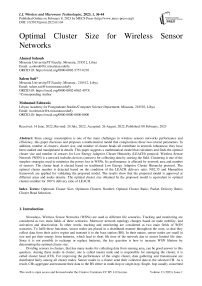Optimal Cluster Size for Wireless Sensor Networks
Автор: Ahmed Sohoub, Salem Sati, Mohamed Eshtawie
Журнал: International Journal of Wireless and Microwave Technologies @ijwmt
Статья в выпуске: 1 Vol.13, 2023 года.
Бесплатный доступ
Since energy consumption is one of the main challenges in wireless sensors networks performance and efficiency, this paper discusses and proposes a mathematical model that compromises these two crucial parameters. In addition, number of clusters, cluster size, and number of cluster heads all contribute in network robustness; they have been studied and manipulated in details. This paper suggests a mathematical model that calculates and finds the optimal cluster size and number of sensors for Low Energy Adaptive Cluster Hierarchy (LEACH) protocol. Wireless Sensor Network (WSN) is a network includes devices (sensors) for collecting data by sensing the field. Clustering is one of the simplest strategies used to minimize the power lost in WSNs. Its performance is affected by network area and number of sensors. The cluster head is elected based on traditional Low Energy Adaptive Cluster Hierarchy protocol. The optimal cluster number is detected based on the condition of the LEACH delivery ratio. NS2.35 and MannaSim framework are applied for validating the proposed model. The results show that the proposed model is approved at different areas and nodes density. The optimal cluster size obtained by the proposed model is equivalent to optimal clusters number for 100 % delivery ratio of LEACH.
Optimum Cluster Size, Optimum Clusters Number, Optimal Cluster Ratio, Packet Delivery Ratio, Cluster Head Selection
Короткий адрес: https://sciup.org/15019202
IDR: 15019202 | DOI: 10.5815/ijwmt.2023.01.04
Список литературы Optimal Cluster Size for Wireless Sensor Networks
- W. R. Heinzelman, A. P. Chandrakasan, and H. Balakrishnan, “Energy- efficient communication protocol for wireless microsensor networks,” in 33rd Annual Hawaii International Conference on System Sciences (HICSS-33), 4-7 January, 2000, Maui, Hawaii, USA. IEEE Computer Society, 2000.
- S. Shi, X. Liu, and X. Gu, “An energy-efficiency optimized LEACH- C for wireless sensor networks,” in 7th International Conference on Communications and Networking in China, Kunming, Yunnan Province, China, August 8-10, 2012. IEEE, 2012, pp. 487–492.
- O. Younis and S. Fahmy, “HEED: A hybrid, energy-efficient, distributed clustering approach for ad hoc sensor networks,” IEEE Trans. Mob. Comput., vol. 3, no. 4, pp. 366–379, 2004.
- S. Kheriji, “Design of an energy-aware unequal clustering protocol based on fuzzy logic for wireless sensor networks,” Ph.D. dissertation, Chemnitz University of Technology, Germany, 2021.
- Gunjan, A. K. Sharma, and K. Verma, “Layered energy balanced unequal clustering and routing (LEBUCR) protocol for wireless sensor networks,” Ad Hoc Sens. Wirel. Networks, vol. 46, no. 1-2, pp. 113–138, 2020.
- A. A. Jasim, M. Y. I. B. Idris, S. R. Azzuhri, N. R. Issa, M. T. Rahman, and M. F. b Khyasudeen, “Energy-efficient wireless sensor network with an unequal clustering protocol based on a balanced energy method (EEUCB),” Sensors, vol. 21, no. 3, p. 784, 2021.
- M. Baniata and J. Hong, “Energy-efficient unequal chain length cluster- ing for wireless sensor networks in smart cities,” Wirel. Commun. Mob. Comput., vol. 2017, 2017.
- Moorthi and R. Thiagarajan, “Energy consumption and network connec- tivity based on novel-leach-pos protocol networks,” Comput. Commun., vol. 149, pp. 90–98, 2020.
- S. Sati, A. Sohoub, A. Eltahar, K. A. B. Ahmad, K. Ahmad, and A. Ba- keer, “Degree contact dc-epidemic routing protocol for opportunistic networks,” 2018 Advances in Wireless and Optical Communications (RTUWO), pp. 198–203, 2018.
- A. Ippisch, S. Sati, and K. Graffi, “Device to device communication in mobile delay tolerant networks,” in 21st IEEE/ACM International Symposium on Distributed Simulation and Real Time Applications, DS- RT 2017, Rome, Italy, October 18-20, 2017. IEEE Computer Society, 2017, pp. 91–98.
- E. Papapetrou and A. Likas, “A replication strategy for mobile oppor- tunistic networks based on utility clustering,” Ad Hoc Networks, vol. 125, p. 102738, 2022.
- I. Daanoune, A. Baghdad, and A. Ballouk, “A comprehensive survey on leach-based clustering routing protocols in wireless sensor networks,” Ad Hoc Networks, vol. 114, p. 102409, 2021.
- G. K. Nigam and C. Dabas, “ESO-LEACH: PSO based energy efficient clustering in LEACH,” J. King Saud Univ. Comput. Inf. Sci., vol. 33, no. 8, pp. 947–954, 2021.
- H. Suleiman and M. Hamdan, “Adaptive probabilistic model for energy- efficient distance-based clustering in wsns (adapt-p): A leach-based ana- lytical study,” J. Wirel. Mob. Networks Ubiquitous Comput. Dependable Appl., vol. 12, no. 3, pp. 65–86, 2021.
- N. M. Zamry, A. Zainal, and M. A. Rassam, “LEACH-CR: energy saving hierarchical network protocol based on low-energy adaptive clustering hierarchy for wireless sensor networks,” in 3rd International Cyber Resilience Conference, CRC 2021, Langkawi Island, Malaysia, January 29-31, 2021. IEEE, 2021, pp. 1–6.
- R. Gantassi, B. B. Gouissem, and J. Ben-Othman, “The use of grid- sizes clustering and k-means algorithms to enhance the qos in LEACH protocol,” in ICC 2021 - IEEE International Conference on Communi- cations, Montreal, QC, Canada, June 14-23, 2021. IEEE, 2021, pp. 1–6.
- R. M. Pereira, L. B. Ruiz, L. H. C. Davantel, and T. R. M. B. Silva, “Powermannasim: An extension with power consumption modeling to mannasim, a wireless sensor network module of NS-2,” in 2015 IEEE Symposium on Computers and Communication, ISCC 2015, Larnaca, Cyprus, July 6-9, 2015. IEEE Computer Society, 2015, pp. 949–955.


